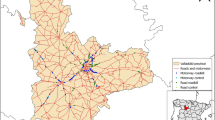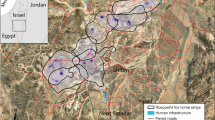Abstract
Roads fragment moose habitat and cause increased mortality through moose–vehicle collisions. Previous studies have found that moose avoid areas near roads. In late winter, when moose face depleting food resources elsewhere, moose may be more prone to use areas near roads for foraging. However, this presumed trade-off between foraging and keeping away from roads has not previously been investigated. We sampled positions from global positioning system-collared moose in late winter from a high-density moose population in Southern Norway that is heavily influenced by human infrastructure. We combined data on moose positions with detailed field surveys of food abundance at sites that were, respectively, intensively used or sparsely used by moose. The probability that a site was intensively used increased with increasing abundance of high-quality browse and also with increasing distance to the nearest road. This indicates that moose trade-off foraging against keeping away from roads. We also found that spatio-temporal movements in relation to roads were influenced by variation in perceived human-derived risk; moose moved closer to smaller roads (low traffic volume) than to major roads (higher traffic volume) and closer to roads at night than at day. Males moved closer to roads than females. In conclusion, moose clearly exhibited behavioural adaptations to cope with roads and traffic in the study area. Because availability of high-quality forage substantially influenced habitat use, it may be an option to establish artificial feeding sites during winter to keep moose away from the roads.



Similar content being viewed by others
References
Andreassen HP, Gundersen H, Storaas T (2005) The effect of scent-marking, forest clearing, and supplemental feeding on moose–train collisions. J Wildl Manag 69:1125–1132. doi:10.2193/0022-541X(2005)069
Arnemo JM, Kreeger TJ, Soveri T (2003) Chemical immobilization of free-ranging moose. Alces 39:243–253
Bednekoff PA (2007) Foraging in the face of danger. In: Stephens DW, Brown JS, Ydenberg RC (eds) Foraging: behaviour and ecology. University of Chicago Press, Chicago, pp 305–329
Benítez-López A, Alkemade R, Verweij PA (2010) The impacts of roads and other infrastructure on mammal and bird populations: a meta-analysis. Biol Conserv 143:1307–1316. doi:10.1016/j.biocon.2010.02.009
Berger J, Swenson JE, Persson I-L (2001) Recolonizing carnivores and naïve prey: conservation lessons from Pleistocene extinctions. Science 291:1036–1039. doi:10.1126/science.1056466
Bergström R, Hjeljord O (1987) Moose and vegetation interactions in northwestern Europe and Poland. Swe Wildl Res 1(suppl 1):213–228
Beyer HL (2004) Hawth’s analysis tools for ArcGIS. URL: http://www.spatialecology.com/index. Accessed 15 Jan 2010
Bolker BM, Brooks ME, Clark CJ, Geange SW, Poulsen JR, Stevens MHH, White J-SS (2008) Generalized linear mixed models: a practical guide for ecology and evolution. Trends Ecol Evol 24:127–135. doi:10.1016/j.tree.2008.10.008
Bjørneraas K, Solberg EJ, Herfindal I, van Moorter B, Rolandsen CM, Tremblay J-P, Skarpe C, Sæther B-E, Eriksen R, Astrup R (2011) Moose Alces alces habitat use at multiple temporal scales in a human-altered landscape. Wildl Biol 17:44–54. doi:10.2981/10-073
Bjørneraas K, Herfindal I, Solberg EJ, Sæther B-E, van Moorter B, Rolandsen CM (2012) Habitat quality influences population distribution, individual space use and functional responses in habitat selection by a large herbivore. Oecologia 168:231–243. doi:10.1007/s00442-011-2072-3
Cederlund G, Ljunqvist H, Markgren G, Stålfelt F (1980) Foods of moose and roe deer at Grimsö in central Sweden. Results of rumen content analyses. Swe Wildl Res 11:169–247
Danell K, Bergström R (eds) (2010) Vilt, människa, samhälle. Lieber AB, Stockholm (in Swedish)
Dussault C, Ouellet J-P, Courtois R, Huot J, Breton L, Jolicoeur H (2005) Linking moose habitat selection to limiting factors. Ecography 28:619–628. doi:10.1111/j.2005.0906-7590.04263.x
Dussault C, Ouellet J-P, Laurian C, Courtois R, Poulin M, Breton L (2007) Moose movement rates along highways and crossing probability models. J Wildl Manag 71:2338–2345. doi:10.2193/2006-499
Dyer SJ, O’Neill JP, Wasel SM, Boutin S (2001) Avoidance of industrial development by woodland caribou. J Wildl Manag 65:531–542
Fahrig L, Rytwinski T (2009) Effects of roads on animal abundance: an empirical review and synthesis. Ecol Soc 14:art 21
Franzmann AW, Schwartz CC (eds) (1998) Ecology and management of the North American moose. Smithsonian Institution Press, Washington
Frid A, Dill LM (2002) Human-caused disturbance stimuli as a form of predation risk. Conserv Ecol 6:11
Forman RTT, Sperling D, Bissonette JA, Clevenger AP, Cutshall CD, Dale VH, Fahrig L, France R, Goldman CR, Heanue K, Jones JA, Swanson FJ, Turrentine T, Winter TC (2003) Road ecology. Science and solutions, Island, Washington
Gill JA, Sutherland WJ, Watkinson AR (1996) A method to quantify the effects of human disturbance on animal populations. J Appl Ecol 33:786–792
Godvik IMR, Loe LE, Vik JO, Veiberg V, Langvatn R, Mysterud A (2009) Temporal scales, trade-offs, and functional responses in red deer habitat selection. Ecology 90:699–710
Hebblewhite M, Merill E (2008) Modelling wildlife–human relationships for social species with mixed-effects resource selection models. J Appl Ecol 45:834–844
Histøl T, Hjeljord O (1993) Winter feeding strategies of migrating and nonmigrating moose. Can J Zool 71:1421–1428. doi:10.1139/z93-196
Hjeljord O, Fjellbakk Å (1982) Taksering av elgskader på skog – en metodevurdering. Rapport 2/82, Institutt for naturforvaltning, Norwegian University of Agriculture, Ås, Norway (in Norwegian)
Jaeger JAG, Bowman J, Brennan J, Fahrig L, Bert D, Bouchard J, Charbonneau N, Frank K, Gruber B, von Toschanowitz KT (2005) Predicting when animal populations are at risk from roads: an interactive model of road avoidance behavior. Ecol Model 185:329–348. doi:10.1016/j.ecolmodel.2004.12.015
Jiang G, Ma J, Zhang M, Stott P (2009) Multiple spatial-scale resource selection function models in relation to human disturbance for moose in northeastern China. Ecol Res 24:423–440. doi:10.1007/s11284-008-0519-8
Kastdalen L (1996) Romerikselgen og Gardermoutbyggingen. Hovedrapport fra Elgprosjektet på Øvre Romerike. Report, Fylkesmannen i Oslo og Akershus, miljøvernavdelingen, 115 pp, Oslo (in Norwegian)
Laurian C, Dussault C, Ouellet J-P, Courtois R, Poulin M, Breton L (2008a) Behavioral adaptations of moose to roadside salt pools. J Wildl Manag 72:1094–1100. doi:10.2193/2007-504
Laurian C, Dussault C, Ouellet J-P, Courtois R, Poulin M, Breton L (2008b) Behavior of moose relative to a road network. J Wildl Manag 72:1550–1557. doi:10.2193/2008-063
Lavsund S, Nygrén T, Solberg EJ (2003) Status of moose populations and challenges to moose management in Fennoscandia. Alces 39:109–130
Leblond M, Dussault C, Ouellet J-P (2010) What drives fine-scale movements of large herbivores? A case study using moose. Ecography 33:1102–1112. doi:10.1111/j.1600-0587.2009.06104.x
Lima SL, Bednekoff PA (1999) Temporal variation in danger drives antipredator behavior: the predation risk allocation hypothesis. Am Nat 153:649–659
Lima SL, Dill LM (1990) Behavioral decisions made under the risk of predation: a review and prospectus. Can J Zool 68:619–640. doi:10.1139/z90-092
Lind J, Cresswell W (2005) Determining the fitness consequences of antipredation behaviour. Behav Ecol 16:945–956. doi:10.1093/beheco/ari075
Linnell JDC, Swenson JE, Andersen R (2001) Predators and people: conservation of large carnivores is possible at high densities if management policy is favourable. Anim Conserv 4:345–349. doi:10.1017/S1367943001001408
Littell RC, Milliken GA, Stroup WW, Wolfinger RD, Schbenberger O (2006) SAS® for mixed models, 2nd edn. SAS Institute Inc., Cary
Lykkja ON, Solberg EJ, Herfindal I, Wright J, Rolandsen CM, Hanssen MG (2009) The effects of human activity on summer habitat use by moose. Alces 45:109–124
Martin J, Basille M, Van Moorter B, Kindberg J, Allainé D, Swenson JE (2010) Coping with human disturbance: spatial and temporal tactics of the brown bear (Ursus arctos). Can J Zool 88:875–888. doi:10.1139/Z10-053
Mysterud A, Lian L-B, Hjermann DØ (1999) Scale-dependent trade-offs in foraging by European roe deer (Capreolus capreolus) during winter. Can J Zool 77:1486–1493
Månsson J, Andrén H, Pehrson Å, Bergström R (2007) Moose browsing and forage availability: a scale-dependent relationship? Can J Zool 85:372–380. doi:10.1139/Z07-015
Neumann W (2009) Moose Alces alces behaviour related to human activity. Dissertation, Swedish University of Agricultural Sciences
Norwegian Public Roads Administration (2010). Nasjonal vegdatabank. Located April 13th 2010 on URL: http://svvgw.vegvesen.no/http://svvnvdbappp.vegvesen.no:7778/ webinnsyn/anon/index
Olsson M, Cox JJ, Larkin JL, Widén P, Olovsson A (2011) Space and habitat use of moose in southwestern Sweden. Eur J Wildl Res 57:241–249. doi:10.1007/s10344-010-0418-5
Ordiz A, Støen O-G, Delibes M, Swenson JE (2011) Predators or prey? Spatio-temporal discrimination of human-derived risk by brown bears. Oecologia 166:59–67. doi:10.1007/s00442-011-1920-5
Ormsby T, Napoleon E, Bruke R, Groessl C, Feaster L (2001) Getting to know ArcGIS desktop: basic of ArcView. ArcEditor and ArcInfo, ESRI, Redland, 541 pp
Panzacchi M, Herfindal I, Linnell JDC, Odden M, Odden J, Andersen R (2010) Trade-offs between maternal foraging and fawn predation risk in an income breeder. Behav Ecol Sociobiol 64:1267–1278. doi:10.1007/s00265-010-0941-0
Parker KL, Robbins CT, Hanley TA (1984) Energy expenditures for locomotion by mule deer and elk. J Wildl Manag 48:474–488
Rea RV, Child KN, Spata DP, MacDonald D (2010) Road and rail side vegetation management implications of habitat use by moose relative to brush cutting season. Environ Manag 46:101–109. doi:10.1007/s00267-010-9502-6
Rogala JK, Hebblewhite M, Whittington J, White CA, Coleshill J, Musiani M (2011) Human activity differentially redistributes large mammals in the Canadian Rockies National Parks. Ecol Soc 16:16. doi:10.5751/ES-04251-160316
Rolandsen CM, Solberg EJ, Herfindal I, Van Moorter B, Sæther B-E (2011) Large-scale spatiotemporal variation in road mortality of moose: is it all about population density? Ecosphere 2:113. doi:10.1890/ES11-00169.1
Rowland MM, Wisdom MJ, Johnson BK, Kie JG (2000) Elk distribution and modeling in relation to roads. J Wildl Manag 64:672–684
Sahlsten J, Bunnefeld N, Månsson J, Ericsson G, Bergström R, Dettki H (2010) Can supplementary feeding be used to redistribute moose Alces alces? Wildl Biol 16:85–92. doi:10.2981/08-085
Sandegren F, Bergström R, Sweanor PY (1985) Seasonal moose migration related to snow in Sweden. Alces 21:39–56
Seiler A (2005) Predicting locations of moose–vehicle collisions in Sweden. J Appl Ecol 42:371–382
Stearns SC (1992) The evolution of life histories. Oxford University Press, New York
Sæther B-E, Andersen R (1990) Resource limitation in a generalist herbivore, the moose Alces alces: ecological constraints on behavioural decisions. Can J Zool 69:993–999. doi:10.1139/z90-143
Torres RT, Carvalho JC, Panzacchi M, Linnell JDC, Fonseca C (2011) Comparative use of forest habitats by roe deer and moose in a human-modified landscape in southeastern Norway during winter. Ecol Res 26:781–789. doi:10.1007/s11284-011-0837-0
van Beest FM, Mysterud A, Loe LE, Milner JM (2010) Forage quantity, quality and depletion as scale-dependent mechanisms driving habitat selection of a large browsing herbivore. J Anim Ecol 79:910–922
van der Ree R, Jaeger JAG, van der Grift EA, Clevenger AP (2011) Effects of roads and traffic on wildlife populations and landscape function: road ecology is moving toward larger scales. Ecol Soc 16:art 48
van Langevelde F, Jaarsma CF (2004) Using traffic flow theory to model traffic mortality in mammals. Landsc Ecol 19:895–907. doi:10.1007/s10980-005-0464-7
Wam HK, Hjeljord O (2010) Moose summer and winter diets along a large scale gradient of forage availability in southern Norway. Eur J Wildl Res 56:745–755. doi:10.1007/s10344-010-0370-4
Wam HK, Hjeljord O, Solberg EJ (2010) Differential forage use makes carrying capacity equivocal on ranges of Scandinavian moose. Can J Zool 88:1179–1191. doi:10.1139/Z10-084
Wood SN (2006) Generalized additive models. An introduction. R. Chapman & Hall/CRC, Boca Raton
Acknowledgments
We thank V. M. Kristiansen and G. O. Strætkvern for assistance in the field. We also thank two anonymous reviewers for constructive comments on a previous draft of the paper. The Norwegian Public Roads Administration provided financial support for the study.
Conflict of interest
The authors declare that they have no conflict of interest.
Ethical standards
This study complies with Norwegian law; immobilisation, handling, GPS-collaring and follow-up of GPS-collared individuals were done with permission from, and in accordance with, the ethical standards provided by, the Directorate for Nature Management and the National Animal Research Authority of Norway.
Author information
Authors and Affiliations
Corresponding author
Additional information
Communicated by P. Acevedo
Electronic supplementary material
Below is the link to the electronic supplementary material.
Online resource 1
(PDF 441 kb)
Online resource 2
(PDF 64 kb)
Online resource 3
(PDF 62 kb)
Online resource 4
(PDF 92 kb)
Rights and permissions
About this article
Cite this article
Eldegard, K., Lyngved, J.T. & Hjeljord, O. Coping in a human-dominated landscape: trade-off between foraging and keeping away from roads by moose (Alces alces). Eur J Wildl Res 58, 969–979 (2012). https://doi.org/10.1007/s10344-012-0640-4
Received:
Revised:
Accepted:
Published:
Issue Date:
DOI: https://doi.org/10.1007/s10344-012-0640-4




